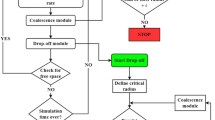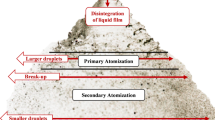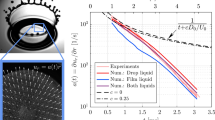Abstract
A major challenge of irrigating limited areas by dropping liquid from a high altitude using aviation is to ensure the required droplet size distribution of the aerosol immediately before contact with the surface to be irrigated. Varying the initial liquid volume and the drop height can provide different droplet sizes in an aerosol cloud when it reaches the irrigated surface. However, it is extremely difficult to predict such aerosol characteristics when using local drop systems. This requires reliable experimental data on the size to which liquid droplets can be atomized when free-falling in a gaseous medium with a variable initial volume and length of the flight path. This paper presents the results of the experimental research into the transformation and subsequent disintegration of free-falling droplets, jets, and non-sprayed arrays of liquid in gas. Using the experimental results, we determined the minimum, average and maximum droplet sizes in the forming aerosol cloud after the deformation and subsequent disintegration of the falling liquid array. When generalizing the experimental findings, we obtained the empirical equation coefficients making it possible to reliably predict the average sizes of liquid droplets when they are dropped as non-sprayed arrays, jets and aerosols from different heights. The research findings can be used to develop effective technologies for supplying liquids with different initial volumes from variable drop heights into the required area, for example, when extinguishing fires or irrigating various areas.
Graphical abstract


















Similar content being viewed by others
Abbreviations
- d m :
-
Average droplet diameter, m
- H :
-
Height of array drop/liquid spraying above the recording area, m
- k 1, k 2, k 3 :
-
Empirical coefficients
- N n :
-
Number concentration of particles, %
- N v :
-
Volume concentration of particles, %
- Q :
-
Volumetric flow rate, ml/s
- R d :
-
Radius of droplet/fragment, mm
- R d av :
-
Average radius of droplet (liquid fragment), mm
- R d max :
-
Maximum radius of droplet (liquid fragment), mm
- Re:
-
Reynolds criterion
- V :
-
Initial volume of array, ml
- V m :
-
Volume of residual array, ml
- V f :
-
Fragment volume, ml
- We:
-
Weber criterion
- δ :
-
Size of liquid jet (diameter or thickness of jet deformation), m
- μ :
-
Viscosity of liquid, Pa·s
- ν :
-
Relative velocity of gas and liquid, m/s
- ρ :
-
Density of liquid, kg/m3
- σ :
-
Surface tension coefficient, N/m
References
Antonov, D.V., Piskunov, M.V., Strizhak, P.A.: Characteristics of the Child-Droplets Emerged by Micro-Explosion of the Heterogeneous Droplets Exposed to Conductive Convective and Radiative Heating. Microgravity. Sci. Technol. 31, 541–555 (2019). https://doi.org/10.1007/S12217-019-9705-2
Berčák, R., Holuša, J., Lukášová, K., Hanuška, Z., Agh, P., Vaněk, J., Kula, E., Chromek, I.: Forest fires in the Czech Republic - characteristics, prevention and firefighting: Review [Lesní požáry v České Republice - charakteristika, prevence a hašení: Review]. Zpravy. Lesn. Vyzk. 63(3), 184–194 (2018)
Cui, Y., Liu, J.: Research progress of water mist fire extinguishing technology and its application in battery fires. Process Saf. Environ. Prot. 149, 559–574 (2021)
Drapalyuk, M., Stupnikov, D., Druchinin, D., Pozdnyakov, E.: Forest fires: Methods and means for their suppression. In: IOP Conference Series: Earth and Environmental Science (2019)
Fan, C.G., Tang, F.: Flame interaction and burning characteristics of abreast liquid fuel fires with cross wind. Exp. Therm. Fluid. Sci. 82, 160–165 (2017). https://doi.org/10.1016/J.EXPTHERMFLUSCI.2016.11.010
Gabbasova, I.M., Garipov, T.T., Suleimanov, R.R., Komissarov, M.A., Khabirov, I.K., Sidorova, L.V., Nazyrova, F.I., Prostyakova, Z.G., Kotlugalyamova, E.Y.: The Influence of Ground Fires on the Properties and Erosion of Forest Soils in the Southern Urals (Bashkir State Nature Reserve). Eurasian. Soil. Sci. 52, 370–379 (2019). https://doi.org/10.1134/S1064229319040070
Gambaryan-Roisman, T., Kyriopoulos, O., Roisman, I., Stephan, P., Tropea, C.: Gravity effect on spray impact and spray cooling. Microgravity. Sci. Technol. 19, 151–154 (2007). https://doi.org/10.1007/BF02915782
Girin, A.G.: Drop deformation and acceleration: The effects of inertia in fragmentation. At. Sprays. 24, 349–366 (2014). https://doi.org/10.1615/AtomizSpr.2013008442
Han, Y., Chen, Z., Liu, H., Nie, Z., Tian, Y.: Virtual reality oriented modeling and simulation of water-dropping from helicopter. In: ACM International Conference Proceeding Series. pp. 24–29 (2018)
Kang, D.G., Nam, G.M., In, W.K., Lee, C.Y.: Evaporation of sessile water droplet on heated surface with needle-shaped nanostructures by pre-boiling oxidation process. Exp. Therm. Fluid. Sci. 101, 193–200 (2019). https://doi.org/10.1016/j.expthermflusci.2018.10.016
Karchevsky, A.L., Cheverda, V.V., Marchuk, I.V., Gigola, T.G., Sulyaeva, V.S., Kabov, O.A.: Heat Flux Density Evaluation in the Region of Contact Line of Drop on a Sapphire Surface Using Infrared Thermography Measurements. Microgravity. Sci. Technol. 33, 53 (2021). https://doi.org/10.1007/S12217-021-09892-6
Liang, T., Liu, M., Liu, Z., Zhong, W., Xiao, X., Lo, S.: A study of the probability distribution of pool fire extinguishing times using water mist. Process. Saf. Environ. Prot. 93, 240–248 (2015). https://doi.org/10.1016/j.psep.2014.05.009
Liu, J., Yang, X., Ma, R., Yuan, Y., Ma, W.: Influence of an External Perpendicular Oscillation on Stability of a Vertical Falling Liquid Film. Microgravity. Sci. Technol. 32(5), 787–805 (2020). https://doi.org/10.1007/S12217-020-09799-8
Magarvey, R.H., Taylor, B.W.: Free Fall Breakup of Large Drops. J. Appl. Phys. 27, 1129–1135 (1956). https://doi.org/10.1063/1.1722216
Muñoz-Feucht, K., Fuentes, A., Consalvi, J.L.: Soot volume fraction measurements in a forest fuel layer. Exp. Therm. Fluid. Sci. 56, 61–68 (2014). https://doi.org/10.1016/J.EXPTHERMFLUSCI.2013.11.007
Nakoryakov, V.E., Kuznetsov, G.V., Strizhak, P.A.: Deformation of a water shell during free fall in air. Dokl. Phys. 61, 195–200 (2016). https://doi.org/10.1134/S1028335816040078
Palaiologou, P., Ager, A.A., Nielsen-Pincus, M., Evers, C.R., Day, M.A.: Social vulnerability to large wildfires in the western USA. Landsc. Urban. Plan. 189, 99–116 (2019). https://doi.org/10.1016/j.landurbplan.2019.04.006
Qureshi, S., Altman, A.: Studying fluid breakup and dispersion to predict aerial firefighting ground drop patterns. In: AIAA Aerospace Sciences Meeting (2018)
Sabo, C., Cohen, K., Kumar, M., Abdallah, S.: Path planning of a fire-fighting aircraft using fuzzy logic. In: 47th AIAA Aerospace Sciences Meeting including the New Horizons Forum and Aerospace Exposition (2009)
Sherstjuk, V., Zharikova, M., Sokol, I.: Forest Fire Monitoring System Based on UAV Team, Remote Sensing, and Image Processing. In: Proceedings of the 2018 IEEE 2nd International Conference on Data Stream Mining and Processing, DSMP 2018. pp. 590–594 (2018)
Shkolnik, I., Pavlova, T., Efimov, S., Zhuravlev, S.: Future changes in peak river flows across northern Eurasia as inferred from an ensemble of regional climate projections under the IPCC RCP8.5 scenario. Clim. Dyn. 50, 215–230 (2018). https://doi.org/10.1007/s00382-017-3600-6
Shlegel, N.E., Strizhak, P.A., Volkov, R.S.: Collision Behavior of Heterogeneous Liquid Droplets. Microgravity. Sci. Technol. 31, 487–503 (2019). https://doi.org/10.1007/S12217-019-9702-5
Shrigondekar, H., Chowdhury, A., Prabhu, S.V.: Characterization of a simplex water mist nozzle and its performance in extinguishing liquid pool fire. Exp. Therm. Fluid. Sci. 93, 441–455 (2018). https://doi.org/10.1016/j.expthermflusci.2018.01.015
Sixue, W., Shi, H., Xiaoqing, W., Jianqiang, L., Qiang, Y., Xiaoyu, L., Yuehai, W., Keqing, N.: Research on Melt Wettability Measurements Under Microgravity. Microgravity. Sci. Technol. 33, 17 (2021). https://doi.org/10.1007/S12217-020-09860-6
Smotr, O., Borzov, Y., Burak, N., Ljaskovska, S.: Implementation of Information Technologies in the Organization of Forest Fire Suppression Process. In: Proceedings of the 2018 IEEE 2nd International Conference on Data Stream Mining and Processing, DSMP 2018. pp. 157–161 (2018)
Stonesifer, C.S., Calkin, D.E., Thompson, M.P., Stockmann, K.D.: Fighting fire in the heat of the day: An analysis of operational and environmental conditions of use for large airtankers in United States fire suppression. Int. J. Wildland. Fire. 25, 520–533 (2016). https://doi.org/10.1071/WF15149
Strizhak, P.A., Volkov, R.S., Zabelin, M.V., Piskunov, M.V.: Disintegration of large balls of water-based liquids in free fall through high-temperature gases. At. Sprays. 27, 893–911 (2017). https://doi.org/10.1615/AtomizSpr.2017018526
Torzhkov, I.O., Kushnir, E.A., Konstantinov, A. V, Koroleva, T.S., Efimov, S. V, Shkolnik, I.M.: The economic consequences of future climate change in the forest sector of Russia. In: IOP Conference Series: Earth and Environmental Science (2019)
Walsh, M., Bil, C.: C-17 conversion system for fire fighting operations. In: 53rd AIAA Aerospace Sciences Meeting (2015)
Wang, S., Hu, J., Xiao, Y., Ren, T., Zhu, F.: Opposed-flow Flame Spread Over Solid Fuels in Microgravity: the Effect of Confined Spaces. Microgravity. Sci. Technol. 27(5), 329–336 (2015). https://doi.org/10.1007/S12217-015-9419-Z
Yin, Z., Su, R., Zhang, W., Ding, Z., Chai, F., Chen, Q., Wang, Q., Liu, F.: Oscillation Characteristics of Single Droplet Impacting Vertically on Smooth Surfaces Using Volume of Fluid Method. Microgravity. Sci. Technol. 33, 58 (2021). https://doi.org/10.1007/S12217-021-09901-8
Zhang, W., Zussman, E., Yarin, A.L.: Heat and mass transfer resulting in eruptive jetting from stems and leaves during distillation stage of forest fire. Exp. Therm. Fluid. Sci. 116, 110112 (2020). https://doi.org/10.1016/J.EXPTHERMFLUSCI.2020.110112
Zhao, H., Li, Y., Qi, Y., Dong, X., Zhang, Y., Zhang, Q.: Experimental study on vertical rigid and flexible polyurethane fire suppression using water spray. J. Thermoplast. Compos. Mater. 089270571987918 (2019). https://doi.org/10.1177/0892705719879185
Zharikova, M., Sherstjuk, V.: The hybrid intelligent diagnosis method for the multiuav-based forest fire-fighting response system. In: 2018 IEEE 13th International Scientific and Technical Conference on Computer Sciences and Information Technologies, CSIT 2018 - Proceedings (2018)
Zhu, P., Wang, X., Tao, C.: Experiment study on the burning rates of ethanol square pool fires affected by wall insulation and oblique airflow. Exp. Therm. Fluid. Sci. 61, 259–268 (2015). https://doi.org/10.1016/J.EXPTHERMFLUSCI.2014.11.006
Zong, R., Kang, R., Liu, C., Zhang, Z., Zhi, Y.: Analysis of Flame Extinguishment and Height in Low Frequency Acoustically Excited Methane Jet Diffusion Flame. Microgravity. Sci. Technol. 30(3), 237–242 (2018). https://doi.org/10.1007/S12217-017-9590-5
Funding
The research was supported by the Russian Science Foundation (project 21–19–00009, https://rscf.ru/en/project/21-19-00009/).
Author information
Authors and Affiliations
Corresponding author
Ethics declarations
Conflict of Interests
The authors have no conflicts of interest to declare.
Additional information
Publisher's Note
Springer Nature remains neutral with regard to jurisdictional claims in published maps and institutional affiliations.
Highlights
• Droplets less than 150 mm in size are practically not disintegrated during free fall
• With an 8–12% droplet concentration in the cloud, size distributions do not change
• Droplet sizes are comparable after 10 m of array, jet, and aerosol falling
• Arrays, jets, and aerosols break up into fragments that differ several-fold in size
• Droplets in aerosol flows tend to coalesce when decelerating in a gas
Rights and permissions
About this article
Cite this article
Kuznetsov, G., Zhdanova, A., Voitkov, I. et al. Disintegration of Free-falling Liquid Droplets, Jets, and Arrays in Air. Microgravity Sci. Technol. 34, 12 (2022). https://doi.org/10.1007/s12217-022-09927-6
Received:
Accepted:
Published:
DOI: https://doi.org/10.1007/s12217-022-09927-6




